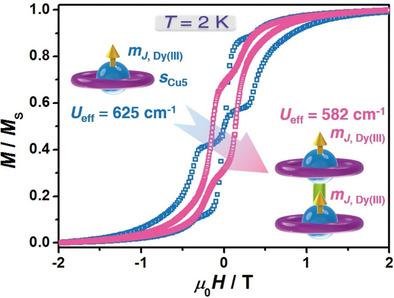当前位置:
X-MOL 学术
›
Angew. Chem. Int. Ed.
›
论文详情
Our official English website, www.x-mol.net, welcomes your
feedback! (Note: you will need to create a separate account there.)
Opening Magnetic Hysteresis by Axial Ferromagnetic Coupling: From Mono‐Decker to Double‐Decker Metallacrown
Angewandte Chemie International Edition ( IF 16.1 ) Pub Date : 2020-11-20 , DOI: 10.1002/anie.202014993 Jin Wang 1 , Quan‐Wen Li 1 , Si‐Guo Wu 1 , Yan‐Cong Chen 1 , Rui‐Chen Wan 1 , Guo‐Zhang Huang 1 , Yang Liu 1 , Jun‐Liang Liu 1 , Daniel Reta 2 , Marcus J. Giansiracusa 2 , Zhen‐Xing Wang 3 , Nicholas F. Chilton 2 , Ming‐Liang Tong 1
Angewandte Chemie International Edition ( IF 16.1 ) Pub Date : 2020-11-20 , DOI: 10.1002/anie.202014993 Jin Wang 1 , Quan‐Wen Li 1 , Si‐Guo Wu 1 , Yan‐Cong Chen 1 , Rui‐Chen Wan 1 , Guo‐Zhang Huang 1 , Yang Liu 1 , Jun‐Liang Liu 1 , Daniel Reta 2 , Marcus J. Giansiracusa 2 , Zhen‐Xing Wang 3 , Nicholas F. Chilton 2 , Ming‐Liang Tong 1
Affiliation

|
Combining Ising‐type magnetic anisotropy with collinear magnetic interactions in single‐molecule magnets (SMMs) is a significant synthetic challenge. Herein we report a Dy[15‐MCCu‐5] (1‐Dy) SMM, where a DyIII ion is held in a central pseudo‐D5h pocket of a rigid and planar Cu5 metallacrown (MC). Linking two Dy[15‐MCCu‐5] units with a single hydroxide bridge yields the double‐decker {Dy[15‐MCCu‐5]}2 (2‐Dy) SMM where the anisotropy axes of the two DyIII ions are nearly collinear, resulting in magnetic relaxation times for 2‐Dy that are approximately 200 000 times slower at 2 K than for 1‐Dy in zero external field. Whereas 1‐Dy and the YIII‐diluted Dy@2‐Y analogue do not show remanence in magnetic hysteresis experiments, the hysteresis data for 2‐Dy remain open up to 6 K without a sudden drop at zero field. In conjunction with theoretical calculations, these results demonstrate that the axial ferromagnetic Dy–Dy coupling suppresses fast quantum tunneling of magnetization (QTM). The relaxation profiles of both complexes curiously exhibit three distinct exponential regimes, and hold the largest effective energy barriers for any reported d–f SMMs up to 625 cm−1.
中文翻译:

通过轴向铁磁耦合来打开磁滞:从单层到双层Metallacrown
在单分子磁体(SMM)中将Ising型磁各向异性与共线磁相互作用结合在一起是一项重大的合成挑战。本文中,我们报告了Dy [15-MC Cu - 5](1-Dy)SMM,其中Dy III离子保持在刚性且平面的Cu 5金属腔(MC)的中央拟D 5 h腔中。将两个Dy [15-MC Cu - 5]单元与单个氢氧化物桥连接会产生双层{Dy [15-MC Cu - 5]} 2(2-Dy)SMM,其中两个Dy III离子的各向异性轴几乎是共线,造成磁弛豫时间为2镝在零外部场中,在2 K时的速度要比1-Dy慢20万倍。尽管1-Dy和经Y III稀释的Dy @ 2-Y类似物在磁滞实验中未显示出剩磁,但2-Dy的磁滞数据保持开放至6 K,而在零磁场处没有突然下降。结合理论计算,这些结果表明,轴向铁磁Dy-Dy耦合抑制了磁化的快速量子隧穿(QTM)。奇怪的是,两种配合物的弛豫曲线都表现出三种不同的指数形式,并且对于任何已报道的625 cm -1的d-f SMM都具有最大的有效能垒。
更新日期:2020-11-20
中文翻译:

通过轴向铁磁耦合来打开磁滞:从单层到双层Metallacrown
在单分子磁体(SMM)中将Ising型磁各向异性与共线磁相互作用结合在一起是一项重大的合成挑战。本文中,我们报告了Dy [15-MC Cu - 5](1-Dy)SMM,其中Dy III离子保持在刚性且平面的Cu 5金属腔(MC)的中央拟D 5 h腔中。将两个Dy [15-MC Cu - 5]单元与单个氢氧化物桥连接会产生双层{Dy [15-MC Cu - 5]} 2(2-Dy)SMM,其中两个Dy III离子的各向异性轴几乎是共线,造成磁弛豫时间为2镝在零外部场中,在2 K时的速度要比1-Dy慢20万倍。尽管1-Dy和经Y III稀释的Dy @ 2-Y类似物在磁滞实验中未显示出剩磁,但2-Dy的磁滞数据保持开放至6 K,而在零磁场处没有突然下降。结合理论计算,这些结果表明,轴向铁磁Dy-Dy耦合抑制了磁化的快速量子隧穿(QTM)。奇怪的是,两种配合物的弛豫曲线都表现出三种不同的指数形式,并且对于任何已报道的625 cm -1的d-f SMM都具有最大的有效能垒。











































 京公网安备 11010802027423号
京公网安备 11010802027423号